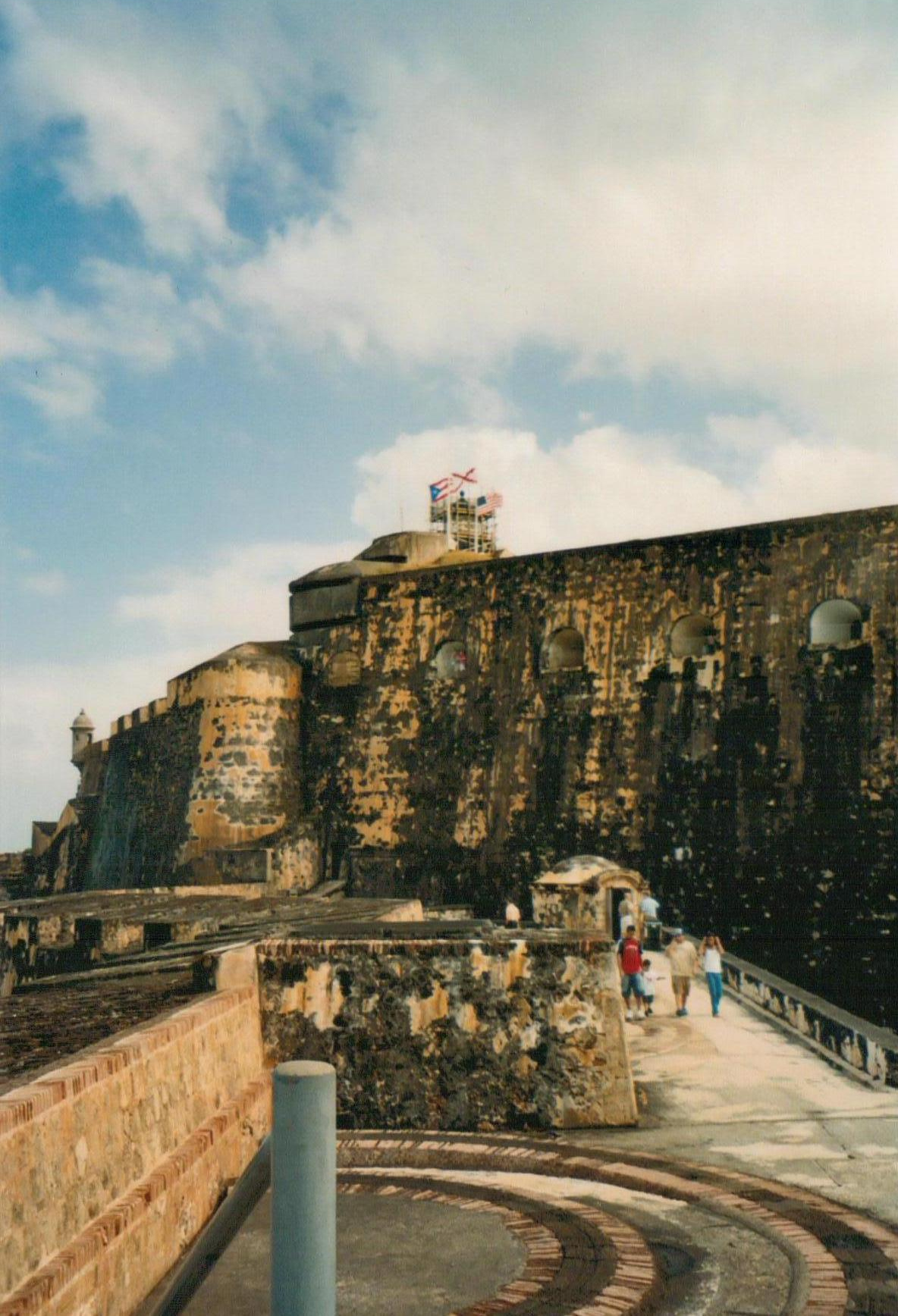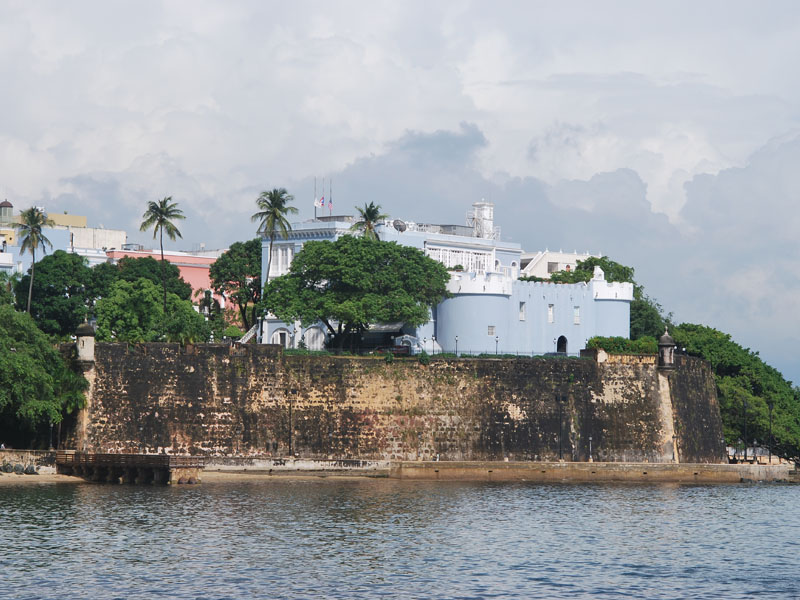|
Old San Juan, Puerto Rico
Old San Juan ( es, Viejo San Juan) is a historic district located at the "northwest triangle" of the islet of San Juan. Its area roughly correlates to the Ballajá, Catedral, Marina, Mercado, San Cristóbal, and San Francisco sub-barrios (sub-districts) of barrio San Juan Antiguo in the municipality of San Juan, Puerto Rico. Old San Juan is the oldest settlement within Puerto Rico and the historic colonial district of the city of San Juan. This historic district is a National Historic Landmark District and is listed on the United States National Register of Historic Places as the Old San Juan Historic District. Several historical buildings and structures, particularly La Fortaleza, the city walls, and El Morro and San Cristóbal castles, have been inscribed in the UNESCO World Heritage Site list since 1983. Historically the mixed use commercial and residential real estate in the main streets like Cristo Street, Fortaleza Street (north) from Tanca Street to the Gover ... [...More Info...] [...Related Items...] OR: [Wikipedia] [Google] [Baidu] |
Castillo San Felipe Del Morro
Castillo San Felipe del Morro, also known as El Morro, is a citadel built between 16th and 18th centuries in San Juan, Puerto Rico.www.nps.gov - San Juan National Historic Site - The Gibraltar of the Caribbean - Accessed on 2014-11-29 Development Lying on the northwesternmost point of the islet of , Castillo San Felipe del Morro is named in honor of King . The fortification, ...[...More Info...] [...Related Items...] OR: [Wikipedia] [Google] [Baidu] |
San Francisco, Old San Juan
San Francisco, within Old San Juan, is one of the 7 subbarrios of San Juan Antiguo barrio in the municipality of San Juan in Puerto Rico. A historic church, the Church of Saint Francis of Assisi, is located in San Francisco. History Puerto Rico was ceded by Spain in the aftermath of the Spanish–American War under the terms of the Treaty of Paris of 1898 and became an unincorporated territory of the United States. In 1899, the United States Department of War conducted a census of Puerto Rico finding that the population of San Francisco was 1,177. In 2010, the population of San Francisco was 796. Saint Francis of Assisi Church ( Church of Saint Francis of Assisi) is located on San Francisco Street. This historic church gives its name to the subdistrict. Some famous Puerto Rican figures such as Impressionist painter Francisco Oller have been buried in its crypt. San Francisco de Asís San Juan 12 2015 02.JPG San Francisco de Asís San Juan 12 2015 04.JPG San Francisco de Asís ... [...More Info...] [...Related Items...] OR: [Wikipedia] [Google] [Baidu] |
San Juan Bay
San Juan Bay ( es, Bahía de San Juan) is the bay and main inlet adjacent to Old San Juan in northeastern Puerto Rico. It is about in length, the largest body of water in an estuary of about of channels, inlets and eight interconnected lagoons. The San Juan Bay is home to the island's busiest harbor and its history dates back to at least 1508. Geography The bay is a semi-enclosed body of water with an elaborate system of loops, basins and channels at the center of Puerto Rico's most significant historical monuments and largest communities. San Juan Bay provides recreation, sightseeing and tourist attractions, and its curved shape offers a variety of docking facilities for watercraft. Because of commercial expansion and environmental stress on the region, the estuary has been the focus of restoration ecology projects. In 2015, the San Juan Estuary Program ( Programa del estuario de la Bahía de San Juan) began using green flags to mark the condition of the bay's waters. On a m ... [...More Info...] [...Related Items...] OR: [Wikipedia] [Google] [Baidu] |
Mainland
Mainland is defined as "relating to or forming the main part of a country or continent, not including the islands around it egardless of status under territorial jurisdiction by an entity" The term is often politically, economically and/or demographically more significant than politically associated remote territories, such as exclaves or oceanic islands situated outside the continental shelf. In geography, "mainland" can denote the continental (i.e. non-insular) part of any polity or the main island within an island nation. In geopolitics, "mainland" is sometimes used interchangeably with terms like metropole as an antonym to overseas territories. In the sense of "heartland", mainland is the opposite of periphery. In some language a separate concept of "mainland" is missing and is replaced with a "continental portion". The term is relative: in Tasmania, continental Australia is the mainland, while to residents of Flinders Island, the main island of Tasmania is also "the ... [...More Info...] [...Related Items...] OR: [Wikipedia] [Google] [Baidu] |
SJ Aerial View 1952
SJ or S.J. may refer to: Postnominal * A member of the Society of Jesus (the Jesuits) Places * Saint John, New Brunswick, a city located in New Brunswick, Canada * San Jose, California, a city located in Northern California, United States * South Jersey, the southern half of the state of New Jersey * St. John's, Newfoundland and Labrador, the capital city in Newfoundland and Labrador, Canada * Subang Jaya, a residential hub in Klang Valley, Malaysia * Suure-Jaani, Estonia * Svalbard and Jan Mayen (ISO 3166-1 country code: SJ), two northern territories of Norway Government, law, and politics * Solicitors Journal * Summary judgment, a legal motion *Social justice, movement for equality Military * Sitara-e-Jurat, Pakistan's third highest military award * SJ radar, a type of S band (10-cm) radar set used on American submarines during the Second World War Sports * San Jose Sharks, a National Hockey League (NHL) team, based in San Jose, California * Show Jumping, a sport on horseb ... [...More Info...] [...Related Items...] OR: [Wikipedia] [Google] [Baidu] |
World Heritage Site
A World Heritage Site is a landmark or area with legal protection by an international convention administered by the United Nations Educational, Scientific and Cultural Organization (UNESCO). World Heritage Sites are designated by UNESCO for having cultural, historical, scientific or other form of significance. The sites are judged to contain " cultural and natural heritage around the world considered to be of outstanding value to humanity". To be selected, a World Heritage Site must be a somehow unique landmark which is geographically and historically identifiable and has special cultural or physical significance. For example, World Heritage Sites might be ancient ruins or historical structures, buildings, cities, deserts, forests, islands, lakes, monuments, mountains, or wilderness areas. A World Heritage Site may signify a remarkable accomplishment of humanity, and serve as evidence of our intellectual history on the planet, or it might be a place of great natural beauty. A ... [...More Info...] [...Related Items...] OR: [Wikipedia] [Google] [Baidu] |
UNESCO
The United Nations Educational, Scientific and Cultural Organization is a List of specialized agencies of the United Nations, specialized agency of the United Nations (UN) aimed at promoting world peace and security through international cooperation in education, arts, sciences and culture. It has Member states of UNESCO, 193 member states and 12 associate members, as well as partners in the Non-governmental organization, non-governmental, Intergovernmental organization, intergovernmental and private sector. Headquartered at the World Heritage Centre in Paris, France, UNESCO has 53 regional field offices and 199 national commissions that facilitate its global mandate. UNESCO was founded in 1945 as the successor to the League of Nations's International Committee on Intellectual Cooperation.English summary). Its constitution establishes the agency's goals, governing structure, and operating framework. UNESCO's founding mission, which was shaped by the Second World War, is to adva ... [...More Info...] [...Related Items...] OR: [Wikipedia] [Google] [Baidu] |
Castillo San Cristóbal (San Juan)
Castillo San Cristóbalwww.nps.gov - San Juan National Historic Site - The Gibraltar of the Caribbean - Consulted el 2014-11-29 is a fortress in , . It was built by the to protect against land-based attacks on the city of San Juan. It is part of |
La Fortaleza
La Fortaleza (lit., "The Fortress" ) is the official residence of the governor of Puerto Rico. It was built between 1533 and 1540 to defend the harbor of San Juan. The structure is also known as Palacio de Santa Catalina (Saint Catherine's Palace). It is the oldest executive mansion in continuous use in the New World. It was listed by UNESCO in 1983 as part of the World Heritage Site "La Fortaleza and San Juan National Historic Site". During the 1640 reconstruction, the chapel of Santa Catalina, which originally stood outside the walls, was integrated into the walls of the structure, resulting in the alternate name Santa Catalina's Castle. The structure La Fortaleza was the first defensive fortification built for the city of San Juan, and the first of a series of military structures built to protect the city which included the Fort San Felipe del Morro and the Fort San Cristóbal. The construction was authorized by Charles V, Holy Roman Emperor as a defense against attacks f ... [...More Info...] [...Related Items...] OR: [Wikipedia] [Google] [Baidu] |
National Register Of Historic Places
The National Register of Historic Places (NRHP) is the United States federal government's official list of districts, sites, buildings, structures and objects deemed worthy of preservation for their historical significance or "great artistic value". A property listed in the National Register, or located within a National Register Historic District, may qualify for tax incentives derived from the total value of expenses incurred in preserving the property. The passage of the National Historic Preservation Act (NHPA) in 1966 established the National Register and the process for adding properties to it. Of the more than one and a half million properties on the National Register, 95,000 are listed individually. The remainder are contributing resources within historic districts. For most of its history, the National Register has been administered by the National Park Service (NPS), an agency within the U.S. Department of the Interior. Its goals are to help property owners and ... [...More Info...] [...Related Items...] OR: [Wikipedia] [Google] [Baidu] |
National Historic Landmark
A National Historic Landmark (NHL) is a building, district, object, site, or structure that is officially recognized by the United States government for its outstanding historical significance. Only some 2,500 (~3%) of over 90,000 places listed on the country's National Register of Historic Places are recognized as National Historic Landmarks. A National Historic Landmark District may include contributing properties that are buildings, structures, sites or objects, and it may include non-contributing properties. Contributing properties may or may not also be separately listed. Creation of the program Prior to 1935, efforts to preserve cultural heritage of national importance were made by piecemeal efforts of the United States Congress. In 1935, Congress passed the Historic Sites Act, which authorized the Interior Secretary authority to formally record and organize historic properties, and to designate properties as having "national historical significance", and gave the Nati ... [...More Info...] [...Related Items...] OR: [Wikipedia] [Google] [Baidu] |
Spanish Colonization Of The Americas
Spain began colonizing the Americas under the Crown of Castile and was spearheaded by the Spanish . The Americas were invaded and incorporated into the Spanish Empire, with the exception of Brazil, British America, and some small regions of South America and the Caribbean. The crown created civil and religious structures to administer the vast territory. The main motivations for colonial expansion were profit through resource extraction and the spread of Catholicism by converting indigenous peoples. Beginning with Columbus's first voyage to the Caribbean and gaining control over more territory for over three centuries, the Spanish Empire would expand across the Caribbean Islands, half of South America, most of Central America and much of North America. It is estimated that during the colonial period (1492–1832), a total of 1.86 million Spaniards settled in the Americas, and a further 3.5 million immigrated during the post-colonial era (1850–1950); the esti ... [...More Info...] [...Related Items...] OR: [Wikipedia] [Google] [Baidu] |

.jpg)


